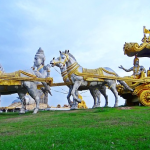In my recent book, Being Different: An Indian Challenge to Western Universalism (2011, HarperCollins India), I’ve discussed how a constant striving for balance and equilibrium between the forces of “chaos” and “order” (rather than the complete annihilation of chaos) permeates Indian philosophy, art, cuisine, music and erotica, distinguishes Indian culture from its Western counterpart and avoids the absolutism of Western sacred literature that views the two poles locked in a zero-sum battle in which only order may triumph. This perpetual reordering, fundamental to Indian culture and religion, has privileged dynamism and creativity, and yielded the diversity evident in Indian life and cultural artifacts.
The difference in attitudes toward order and chaos is one of the chief differences discussed at length in the book. It is worth considering why the Indian religious imagination so unequivocally embraced the notion of diversity and multiplicity while others have not to a similar extent. Since all civilizations have tried to answer such existential questions as who we are, why we are here, what the nature of the Divine and the cosmos are etc., why are some Indian answers so markedly different from the Abrahamic ones?
Sri Aurobindo offers us a clue. In Dharmic traditions, unity is grounded in a sense of the Integral One, and there can be immense multiplicity without fear of “collapse into disintegration and chaos”. He suggests that the “forest” with the “richness and luxuriance of its vegetation” is both an inspiration and metaphor for India’s spiritual outlook. A quick look at world cultures and civilizations reveals how profoundly the geography and the human response to it affected those cultures. So it may well be that the physical features and characteristics of the subcontinent, once lush with tropical forests, also contributed to its deepest spiritual values (in contrast to those that were born, as the Abrahamic religions are, in the milieu of the desert).
The forest has always been a symbol of beneficence in India – a refuge from the heat, and abundant enough to support a life of contemplation without the worries of survival when worldly ties had to be severed for the pursuit of spiritual goals. (The penultimate stage of life advocated for individuals in Dharma traditions is called “vanaprastha” or “the forest stage of life”). Forests support thousands of species that survive interdependently and contain complex life and biology that changes and grows organically. Forest creatures are adaptive; they mutate and fuse into new forms easily. The forest loves to play host; newer life forms migrate to it and are rehabilitated as natives. Forests are ever evolving, their dance never final or complete.
Indian thought, analogously, favors plurality, adaptation, interdependence and evolution. Diversity is natural, normal and desirable, an expression in fact of God’s immanence. Just as there are virtually unlimited species and processes in the forest, so there are infinite ways of Dharmic practice including communicating with God. The plethora of scriptures, rituals, deities, festivals and traditions are not seen as “chaos” but harmoniously interwoven, reconfiguring themselves quite organically as time and place dictate. Life-giving forests and nature are not intended for man’s “dominion” (as they are in the Abrahamic religions) but are part of the same cosmic family as man. Sri Aurobindo emphasizes this natural predisposition to pluralism in the Indian mind where “the Infinite must always present itself in an endless variety of aspects” and contrasts this to the religious mindset of the West which has privileged the “idea of a single religion for all mankind […], one set of dogmas, one cult, one system of ceremonies, one array of prohibitions and injunctions, one ecclesiastical ordinance”.
In Being Different, I posit that just as forests may have inspired and shaped Dharmic thinking, so too have deserts, the dominant landscape of the Middle-East where the Abrahamic faiths arose, left their imprint on the ethos of those faiths. Deserts can be hostile places and are not places to easily dwell in permanently, or to marvel at the diversity of life. The vast emptiness and unique beauty of a desert does instill awe and humility, but also fear. Deserts generally connote starkness, a paucity of life, harsh environs and danger. The desert has fewer types of life and less multiplicity in general. Desert dwellers look to overcome their harsh circumstances by turning to a God above. The Abrahamic religious ethos is built on this sense of awe and fear. Nature is not supportive but profoundly threatening – an enemy to be tamed, civilized and controlled. The divine is less a nurturing mother than an austere and oftentimes angry father. The desert, like its climate, seems to lend itself to extremes of religious experience. God rescues man by offering strict and immutable do’s and don’ts – the Ten Commandments. For their obedience, He confers grace and mercy on men but expects the deepest repentance and atonement. Those who disobey get punished in draconian ways, and there is only one life in which to prove oneself with no second chance through reincarnation.
Geography however, is only one contributor to the differences between Indian and Western thought. In my next blog, I will discuss how attitudes toward history further differentiate India from the West.















